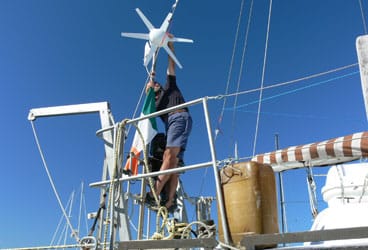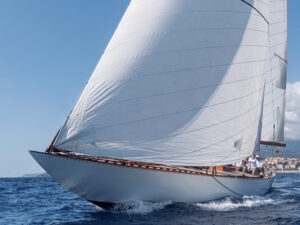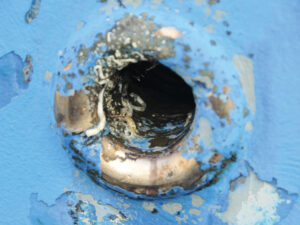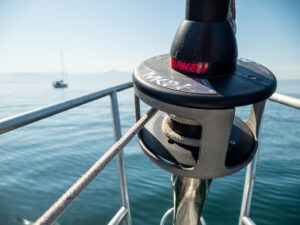
wind generator
For 15 years and thousands of miles of cruising, my partner, Peter Maxwell, had crunched the numbers and came to the conclusion that no “alternative” way of generating electricity aboard Mithril, our 50-foot Van de Stadt-designed steel ketch, worked out to be more economical than diesel. This was in spite of the fact that we ran the engine every day to keep the fridge/freezer cold. In the tropics, it was as long as two hours per day.
During those years, Mithril‘s power was supplied solely by an 80-horsepower Ford New Holland engine with a 120-amp-hour alternator and stored in three 180-amp-hour batteries, with one kept solely for engine starting. But in 2006, when we were preparing for a mostly cold-water, high-latitudes cruise, the falling price of “alternative” power-producing gadgetry and the increasing cost of diesel led us to consider installing a wind generator. For the first time, the figures showed that it would pay for itself over the proposed three-year length of the cruise. In fact, it took less than half that time to recoup the cost because we were able to modify our power usage in ways that were unforeseen by us at the outset. We selected the British-made Rutland 913 Windcharger and mounted it on the stern pulpit on a single stainless-steel pole. Despite Mithril having already sailed 180,000 miles, it wasn’t until we stuck the wind generator on the back end that people said that our boat now looked like a proper, serious cruiser.
As Mithril is a steel boat, we feared that any noise or vibration would be amplified below. Vibration turned out to be a problem only in very strong winds. We quickly got used to hearing the swish of wind through the blades and used the sound as a convenient way to gauge wind strength without even having to look outside. This was the first unanticipated benefit.
In addition to the fridge/freezer, the electric autopilot aboard Mithril was another big “gas guzzler.” In the old days, every scrap of power was conserved to feed the beast—no lights at night, limited computer use, and even the BBC World Service was rationed at times. But now with our wind generator, we had so much extra power that we could afford to use a reading light that wouldn’t ruin our night vision.
Being confirmed meat eaters, we still ran the engine daily for our freezer. During our previous circumnavigation, we found that in the colder waters of the Southern Ocean, only 30 minutes per day was required to keep meat frozen. This time, however, when anchored at Kerguelen Island, at 50 degrees south in the Indian Ocean, we found that running the engine for only 15 minutes every second day was sufficient. This was partly because of the cold water and surprisingly due to our move to vacuum-sealed meats. A butcher in Cape Town, South Africa, had vacuum-sealed packs of boneless lamb, beef, and chicken for us. The vacuum-sealed meats keep for three to four months if well chilled; there’s no need to freeze them. Our pre-purchase estimates hadn’t envisaged this degree of savings; our diesel consumption, predicted to drop by 33 percent, actually decreased by 50 percent.
Another aspect of our drive to reduce diesel consumption and maximize the wind generator’s output led us to buy a 1.5-kilowatt inverter, which ran everything from the clothes dryer to an angle grinder. Only the anchor windlass was beyond its capacity. This in turn led us to use the microwave more, which produced a surprising 50-percent reduction in cooking-gas consumption. The icing on the cake, or the jam on the loaf, occurred when we found that we had enough power to run a bread maker. We had some disasters, initially, when a hiccup in the power supply would make the kneading motor kick in near the end of the baking cycle, giving us beautiful, crusty-topped loaves that were hollow underneath. The motor soon burned out, so we kneaded the dough by hand and used the bread oven for proofing and baking. This was a special bonus in cold climates where proofing dough can be a torment. When sailing, we needed to compensate for the heel of the boat by raising one side of the machine to keep it level—a new meaning for the expression “hard tack.”
With both diesel and propane bills reduced by 50 percent, the wind generator paid for itself in a year. However, in the windiest conditions, the wind generator proved itself to be useless. During gales, we found ourselves once again saddled with dark nights and day-old bread. The instruction manual does warn that this is likely: “In high winds, the Windcharger’s built-in thermostat may operate to prevent the generator from overheating. In this mode, the output will cease, and the turbine will temporarily speed up until such time as the lower-level temperature is reached.”
“Speed up” is an inadequate way to describe a noise that begins with a long, drawn-out, high-pitched whheeeee! followed by a deeper, booming vrruumm! as the unit turns downwind. The first time it happened, in the pitch dark, of course, I nearly had a heart attack. I thought that a vital component had come undone, and with visions of the blades turning into a deadly Frisbee, I cowered below. The manual goes on to say that “this cutting out may be seen to cycle in prolonged high winds, particularly in high ambient temperatures.” For this, read: “You’ll experience heart palpitations in winds above 30 knots and in all temperatures.” However, we can get used to anything, in time, and pretty soon we were laying wagers with each other as to when our wailing banshee would arrive.
This section of the manual concludes with some sage advice: “If safely accessible, you may prefer to temporarily secure the turbine.” Yeah, right! As per the manual again: “The wind generator should be mounted in a safe position, a minimum of 2.3 meters (7 feet 6 inches) above the deck.” Climbing the stern pulpit and lassoing this whirling dervish in 30 knots of breeze and an ocean swell wouldn’t be something for which I’d volunteer.
When we arrived in Australia, our wind generator, we discovered, had one last unexpected benefit to bestow on us. At the weekly barbie organized by the community of liveaboard cruisers, Peter found himself the star attraction: All the sailors kept asking him to do his spirited imitation of our Windcharger, complete with every whheeeee! and booming vrruumm! and a blur of waving-arm spinning blades.
The reality is this: While wind generators can indeed be entertaining, they’re also economical and environmentally friendly, and no serious cruiser should be without one.
After 18 years and 180,000 miles of ocean cruising, Geraldine Foley and Peter Maxwell sold Mithril. Now they’re back on the water aboard a 32-foot fiberglass river cruiser, and this year they explored 800 miles (with 750 manually operated locks) of the English canal system.








